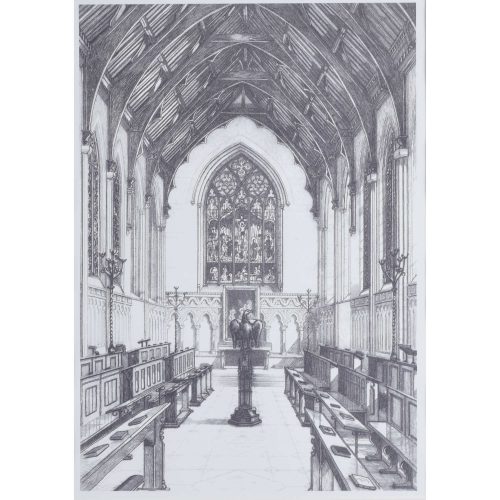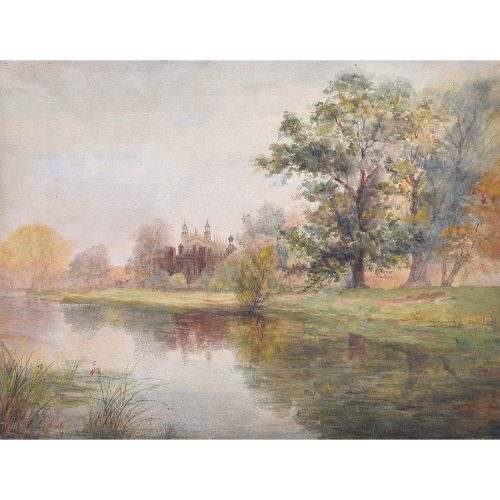-
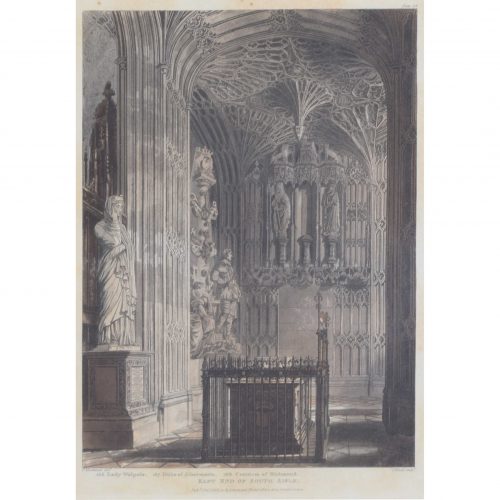
J Black (early 19th century) after Frederick Mackenzie (1788 - 1854)
East End of South Aisle, Westminster Abbey (1812)
Hand-coloured aquatint 31 x 24 cm Published by Rudolph Ackermann (1764 - 1834). An engraving of the East End of Westminster Abbey's south aisle. Mackenzie's drawing was engraved by Black and published by Ackermann in his 1812 "History of Westminster Abbey". Charles II, Queen Anne, Queen Mary II and her husband King William III, and Mary, Queen of Scots are all buried in the south aisle. The Abbey is an historic, mainly Gothic church in the City of Westminster, London, just to the west of the Palace of Westminster. It is one of the United Kingdom's most notable religious buildings and since Edward the Confessor, a burial site for English and, later, British monarchs. Since the coronation of William the Conqueror in 1066, all coronations of English and British monarchs have occurred in Westminster Abbey. Sixteen royal weddings have occurred at the abbey since 1100. According to a tradition first reported circa 1080, a church was founded at the site (then known as Thorney Island) in the seventh century, in the time of Mellitus, Bishop of London. Construction of the present church began in 1245 on the orders of Henry III. Frederick Mackenzie (1788 - 1854) was a British watercolourist and architectural draughtsman. He first exhibited at the Royal Academy in 1804, and contributed eleven drawings between that year and 1828. He contributed to the Society of Painters in Water Colours exhibitions from 1813, becoming an associate in 1822, and a full member the following year. From 30 November 1831 till his death he was treasurer to the society. In later life Mackenzie was no longer commissioned to illustrate books. Rudolph Ackermann was an Anglo-German bookseller, inventor, lithographer, publisher and businessman. In 1795 he established a print-shop and drawing-school at 96 Strand. Here Ackermann set up a lithographic press and began a trade in prints. He later began to manufacture colours and thick carton paper for landscape and miniature painters. Within three years the premises had become too small and he moved to 101 Strand, in his own words "four doors nearer to Somerset House", the seat of the Royal Academy of Arts. Between 1797 and 1800 Ackermann rapidly developed his print and book publishing business, encompassing many different genres including topography, caricature, portraits, transparencies and decorative prints. Condition: good. Some age toning. If you’d like to know more, please email info@manningfineart.co.uk or call us on 07929 749056. -

J Black (early 19th century) after Frederick Mackenzie (1788 - 1854)
The Choir, Westminster Abbey (1812)
Hand-coloured aquatint 28 x 19 cm Published by Rudolph Ackermann (1764 - 1834). An engraving of the vast and soaring interior of Westminster Abbey. Mackenzie's drawing was engraved by Black and published by Ackermann in his 1812 "History of Westminster Abbey". The Abbey is an historic, mainly Gothic church in the City of Westminster, London, just to the west of the Palace of Westminster. It is one of the United Kingdom's most notable religious buildings and since Edward the Confessor, a burial site for English and, later, British monarchs. Since the coronation of William the Conqueror in 1066, all coronations of English and British monarchs have occurred in Westminster Abbey. Sixteen royal weddings have occurred at the abbey since 1100. According to a tradition first reported circa 1080, a church was founded at the site (then known as Thorney Island) in the seventh century, in the time of Mellitus, Bishop of London. Construction of the present church began in 1245 on the orders of Henry III. Frederick Mackenzie (1788 - 1854) was a British watercolourist and architectural draughtsman. He first exhibited at the Royal Academy in 1804, and contributed eleven drawings between that year and 1828. He contributed to the Society of Painters in Water Colours exhibitions from 1813, becoming an associate in 1822, and a full member the following year. From 30 November 1831 till his death he was treasurer to the society. In later life Mackenzie was no longer commissioned to illustrate books. Rudolph Ackermann was an Anglo-German bookseller, inventor, lithographer, publisher and businessman. In 1795 he established a print-shop and drawing-school at 96 Strand. Here Ackermann set up a lithographic press and began a trade in prints. He later began to manufacture colours and thick carton paper for landscape and miniature painters. Within three years the premises had become too small and he moved to 101 Strand, in his own words "four doors nearer to Somerset House", the seat of the Royal Academy of Arts. Between 1797 and 1800 Ackermann rapidly developed his print and book publishing business, encompassing many different genres including topography, caricature, portraits, transparencies and decorative prints. Condition: good. Some age toning. If you’d like to know more, please email info@manningfineart.co.uk or call us on 07929 749056. -
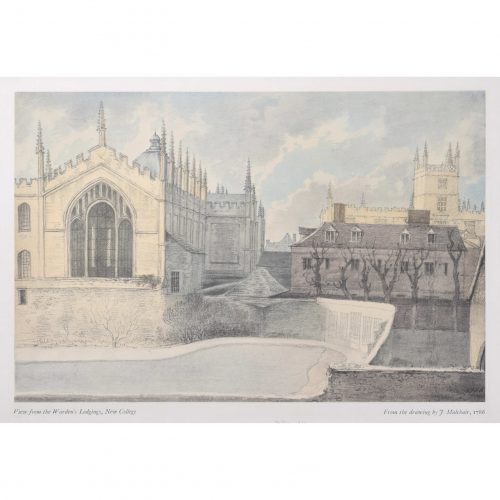
John Baptist Malchair (1730 – 1812)
View from the Master's Lodgings, New College, Oxford (1929)
Lithograph 33 x 46 cm A 1929 lithograph from a 1767 watercolour of New College by John Malchair. The artist's composition highlights the pale stone of New College on a winter's day. The chapel's spires stretch upward into a cold, cloud-filled sky, as do the bare branches of the trees. Malchair's watercolour (which is held by the Ashmolean museum) was reproduced as a lithograph in 1929, to be published in the "Oxford Almanack". The Oxford Almanack was an annual almanac published by the Oxford University Press for the University of Oxford from 1674 through 2019 (when printing sadly ceased due to "dwindling interest"). The almanac traditionally included engravings or lithographs of the University and information about the upcoming year. Other almanac artists have included James Basire, Michael Burghers, J. M. W. Turner, and John Piper. Malchair was a German-born watercolourist, violinist, drawing master, and collector of traditional European music. He is described as “one of the most distinctive figures of eighteenth century Oxford”, and is recognised as having been an influence on later landscape artists, including John Constable. Malchair was a talented artist, producing hundreds of paintings of English landscapes. His legacy is the collection of hundreds of sketches and watercolours of historical, architectural and topographical interest, particularly of Oxford's medieval buildings. Condition: very good. If you’d like to know more, please email info@manningfineart.co.uk or call us on 07929 749056. -
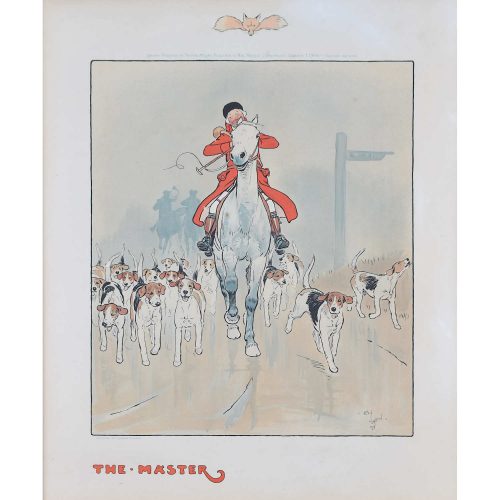
Cecil Aldin (1870 - 1935)
The Master
Lithograph 48 x 40 cm A jolly lithograph of an MFH and his hounds. Cecil Charles Windsor Aldin was a British artist and illustrator best known for his paintings and sketches of animals, sports, and rural life. Aldin executed village scenes and rural buildings in chalk, pencil, and also wash sketching. He was an enthusiastic sportsman and a Master of Fox Hounds, and many of his pictures illustrated hunting. Aldin's early influences included Randolph Caldecott and John Leech. Condition: generally very good, a few marks to margins, one or two marks to frame. -
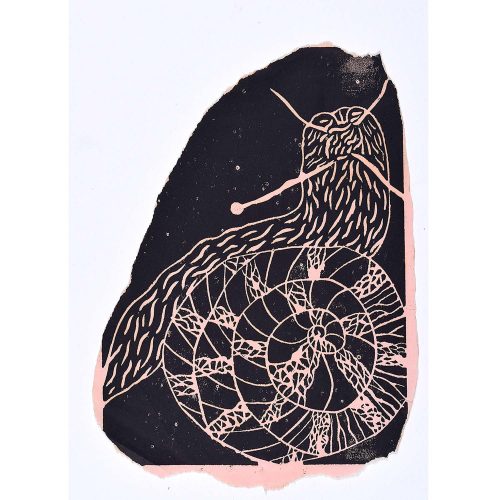
Rosemary Ellis (1910-1988) Snail Sitting Up
23.5x17cm Linocut Provenance: the family of the artist, by descent. Rosemary Ellis (1910-1988)Click here for biographical details and other works by the artist. Clifford and Rosemary Ellis were famous as a husband and wife team for their fascination with nature and their vibrant and charming depictions of animals. They were the natural artists to be commissioned by Collins for their ‘New Naturalists’ series of books, which have become famous and highly collectable more for the dust jackets designed by the Ellises than for the – otherwise excellent – content. This painting is from a recently discovered series of paintings and drawings, never before seen by the general public, dating from the 1940s and 1950s. If you are interested email info@manningfineart.co.uk or call us on 07929 749056. Condition: Good, rough edges as done by artist. -
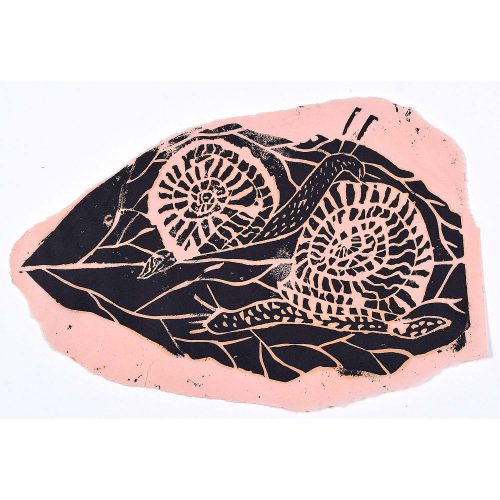
Rosemary Ellis (1910-1988) Snail on Leaf
15x24cm LinocutProvenance: the family of the artist, by descent. Click here for biographical details and other works by the artist. Clifford and Rosemary Ellis were famous as a husband and wife team for their fascination with nature and their vibrant and charming depictions of animals. They were the natural artists to be commissioned by Collins for their ‘New Naturalists’ series of books, which have become famous and highly collectable more for the dust jackets designed by the Ellises than for the – otherwise excellent – content. This painting is from a recently discovered series of paintings and drawings, never before seen by the general public, dating from the 1940s and 1950s. If you are interested email info@manningfineart.co.uk or call us on 07929 749056. Condition: Good, rough edges as done by artist. -
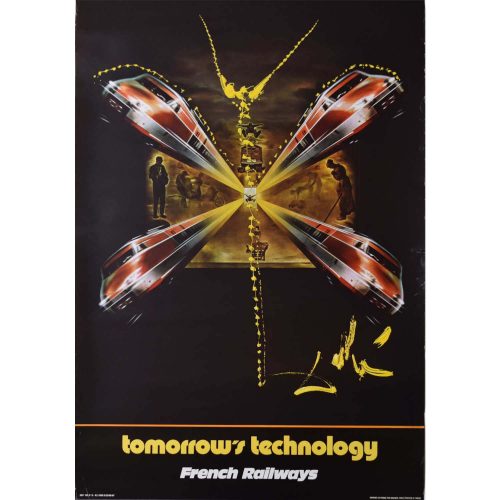
Salvador Dali Tomorrow's Technology
Original Poster for French Railways SNCF 60x37cm 1976 Signed in the plate Dali designed posters for SNCF for several years, a fruitful relationship. If you are interested email info@manningfineart.co.uk or call us on 07929 749056. Condition: Generally very good. -
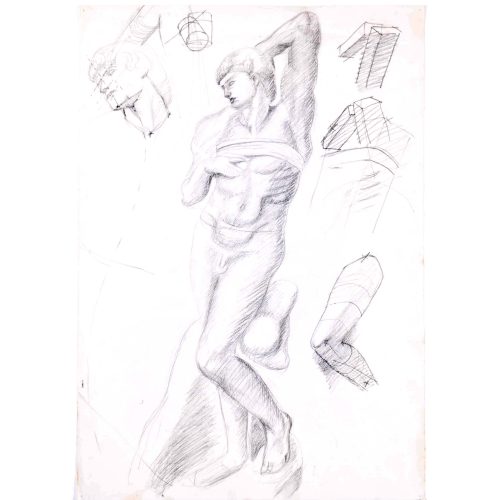
Hilary Hennes (née Hilary Miller) (1919-1993) Sketches of Figures c. 1940
56x39cm Pencil sketch A well-executed sketch. Miller was born in London, where her father was a curator at the South London Art Gallery. She attended Blackheath High School and, from 1936 to 1940, studied at the Blackheath School of Art and then for a further three years at the Royal College of Art. After graduating, Miller taught at the South East Sussex Technical College and in 1946 married the artist Hubert Hennes. The couple set up home in Oxford, where they both held teaching posts at the Oxford School of Art. Between 1948 and 1967 Miller frequently exhibited paintings at the Royal Academy in London and also illustrated a number of books on gardening and natural history, such as The Living World and Boff's Book of Gardening. If you are interested email info@manningfineart.co.uk or call us on 07929 749056. Condition: Generally very good condition, pin holes to corners toning to edge of sheet and occasional soft creases towards edges. -
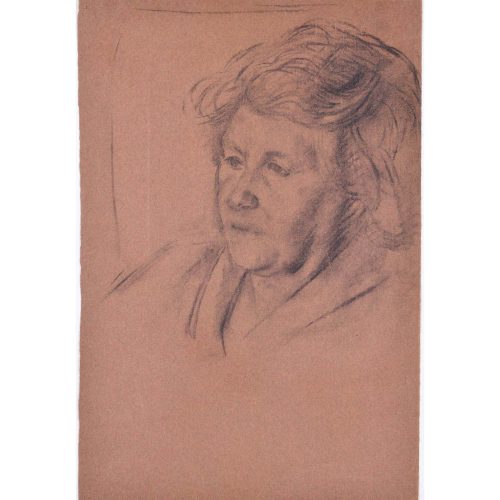
Hilary Hennes (née Hilary Miller) (1919-1993) Sketch of a Woman c. 1940
48x32cm Charcoal A well-executed sketch of a woman's face. Miller was born in London, where her father was a curator at the South London Art Gallery. She attended Blackheath High School and, from 1936 to 1940, studied at the Blackheath School of Art and then for a further three years at the Royal College of Art. After graduating, Miller taught at the South East Sussex Technical College and in 1946 married the artist Hubert Hennes. The couple set up home in Oxford, where they both held teaching posts at the Oxford School of Art. Between 1948 and 1967 Miller frequently exhibited paintings at the Royal Academy in London and also illustrated a number of books on gardening and natural history, such as The Living World and Boff's Book of Gardening. If you are interested email info@manningfineart.co.uk or call us on 07929 749056. Condition: Generally excellent condition, pin holes to corners. -

Claude Harrison Shell Guide to Westmoreland
Original poster for Shell Oil c. 1960s 76x51cm Shell commissioned a series of posters to go with their County Guide books, and they commissioned paintings by the leading artists of the day. Claude Harrison studied at Preston College of Art (1939-1941) and Liverpool College of Art (1941-2) after which he enlisted in the RAF for five years. On his return, he continued studies at Royal College of Art (1947-50). Harrison’s work consisted of murals, portraits, conversation pieces and mystical figure compositions - which are seen here in the Westmoreland poster. He was a member of the Royal Academy and his work has regularly been exhibited in the annual summer exhibition. If you are interested email info@manningfineart.co.uk or call us on 07929 749056. Condition: Fair. Short edge tears which are hidden by mount/mat; some age toning. Metal hanger removed to allow matting. See photograph for more information -
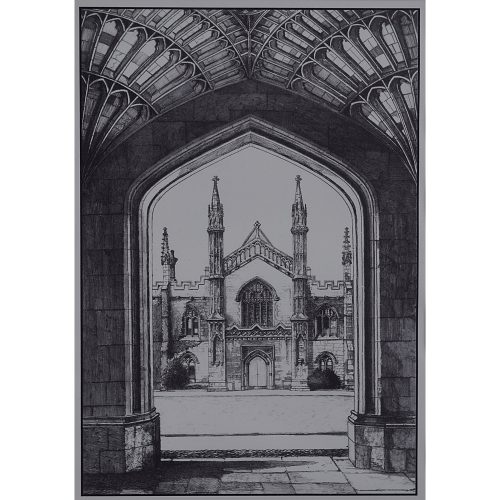
Tony Broderick (British, late 20th Century) Corpus Christi College Cambridge
Print 35x25cm A Lincoln-based artist, known for his portrayal of Lincoln and also of the Cambridge Colleges. If you are interested email info@manningfineart.co.uk or call us on 07929 749056. Condition: Excellent. -
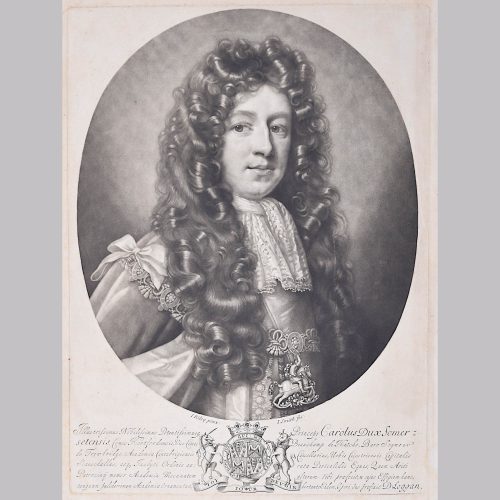
David Loggan (1634-1692) Charles Duke of Somerset
Mezzotint 1690 35x25cm Chancellor of Cambridge University, the Duke of Somerset's portrait was in Loggan's Cantabrigia Illustrata. Baptised in Danzig in 1634 Loggan's parents were English and Scottish. Studying engraving in Danzig with Willem Hondius (1598-1652 or 1658) he moved to London in the late 1650s producing the engraved title-page for the folio 1662 Book of Common Prayer. Marrying in 1663 he moved to Nuffield, Oxfordshire in 1665 to avoid the Plague and was in 1668/9 appointed Public Sculptor to the nearby University of Oxford having been commissioned to produce bird’s-eye views of all the Oxford Colleges. He lived in Holywell Street as he did this. Oxonia illustrata was published in 1675, with the help of Robert White (1645-1704). Following its completion he commenced work on his equivalent work for Cambridge, Cantabrigia Illustrata which was finally published in 1690 when he was made engraver to Cambridge University. Oxonia illustrata also includes an engraving of Winchester College (sharing its founder – William of Wykeham – with New College) whilst Cantabrigia illustrata includes one of Eton College (which shares its founder – Henry VIII – with King’s College). Bird’s-eye views required a particular talent as an architectural perspectivist of that era as it was not until 1783 that the first living thing (a sheep, named Montauciel ‘climb to the sky’) was sent aloft by the Mongolfier brothers in a balloon. Loggan thus had to rely on his imagination in conceiving the views. Loggan’s views constitute the first accurate depictions of the two Universities, in many ways unchanged today. Whilst the Oxford engravings were produced in reasonable numbers and ran to a second edition by Henry Overton (on thicker paper and with a plate number in the bottom right-hand corner), those of Cambridge were printed in smaller numbers and it is thought largely no second edition was produced, although this frontispiece proudly claims to have been published by Overton and a pencil note on the print suggests 1715 as a date. The Dutchman Pieter van der Aa published some miniature versions of the engravings for James Beverell’s guidebook to the UK Les Delices de la Grande Bretagne c. 1708. Edmund Hort New (1871-1931) produced a series of pen-and-ink drawings of views of Oxford that paid homage to Loggan showing the development of the city in the following two hundred years. They were turned into photoengravings by Emery Walker who published the series between . Probably no more than two hundred of each engraving were produced and the plates were destroyed in the blitz. The contemporary artist Andrew Ingamells (b.1956) has produced a highly-acclaimed series of etchings again bringing Loggan’s vision up to date. If you are interested email info@manningfineart.co.uk or call us on 07929 749056. Condition: Good. -
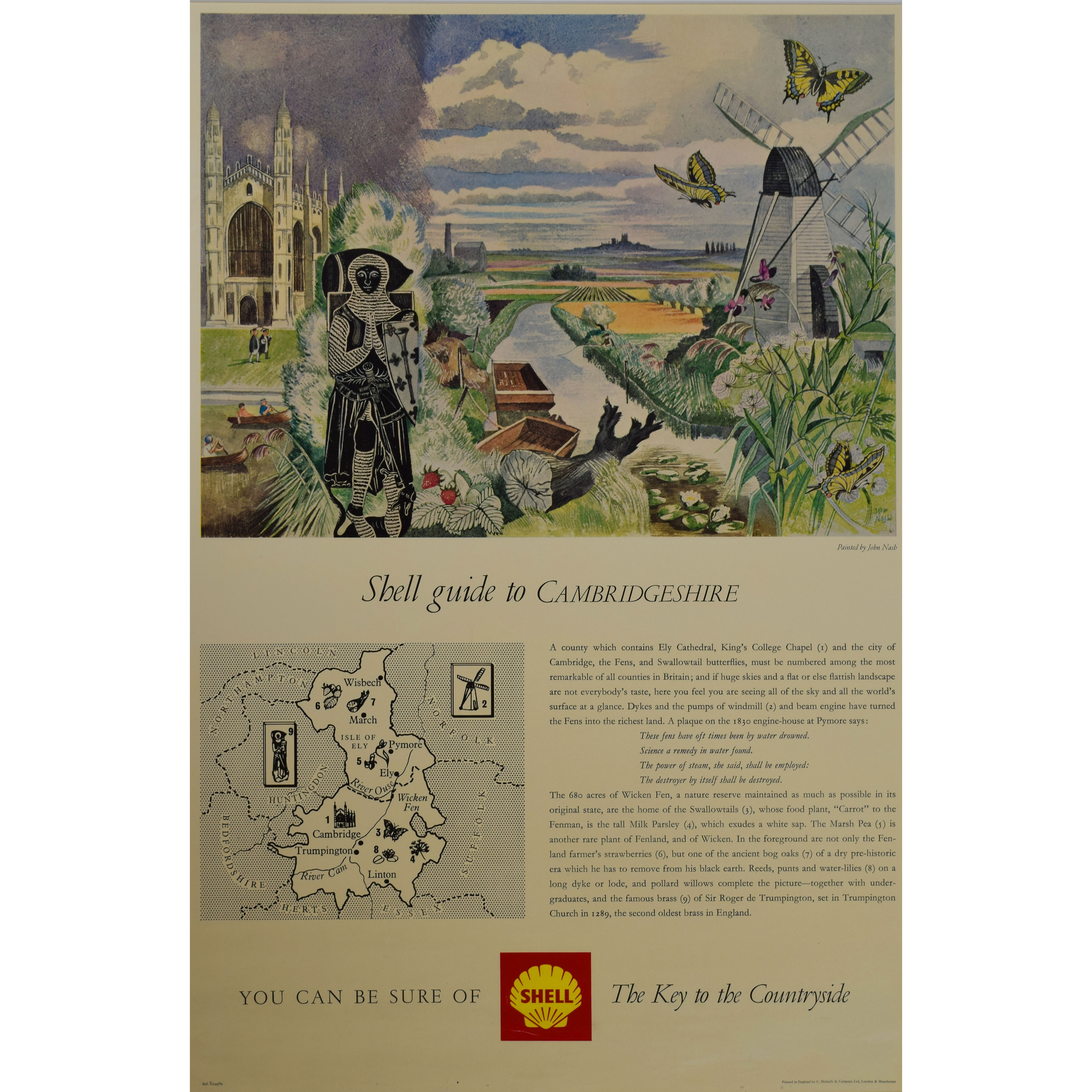
John Nash
Shell Guide to Cambridgeshire Original poster c. 1960s 76x51cm Shell commissioned a series of posters to go with their County Guide books, and they commissioned paintings by the leading artists of the day. Nash needs no introduction as an artist. A painter of landscapes and still-lives and illustrator - particularly of botanic works - who worked extensively with wood engravings, he was a natural choice for Shell. His most famous work is probably 'Over the Top' which hangs in the Imperial War Museum, relating to a counter-attack by 1st Battalion Artists' Rifles at Welsh Ridge on 30 December 1917. Of the eighty men who went over the top, sixty-eight were killed or wounded within the first few minutes. Nash escaped and painted the picture three months later. The Tate holds his 1918 painting 'The Cornfield' which was his first non-war painting (he only started painting in oils in 1914). Condition: mounted in conservation mount and wrapped in plastic sleeve (mount hides short edge tears). -
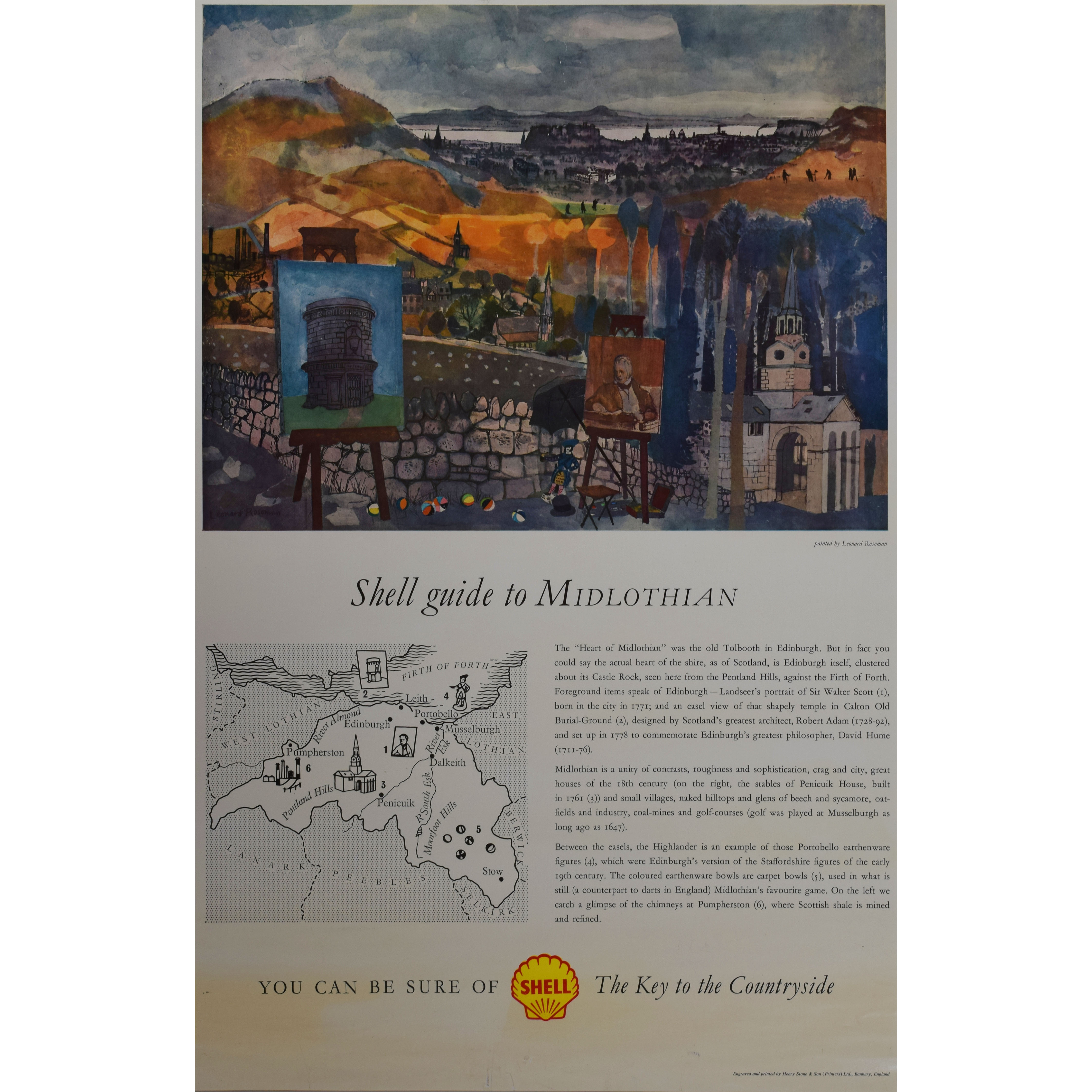
Leonard Rosoman
Shell Guide to Midlothian Original poster c. 1960s 76x51cm Shell commissioned a series of posters to go with their County Guide books, and they commissioned paintings by the leading artists of the day. Born in London, Rosoman studied at the Royal Academy Schools and then the Central School. His first major commission was to illustrate the popular children's book 'My Friend Mr Leakey' in 1937. Joining the Auxiliary Fire Service during World War II, he painted many scenes from the Blitz, some of which are in the Imperial War Museum collection. Seconded to the War Office in 1943 to illustrate books on fire-fighting the War Artists' Advisory Committee gave him a full-time post with the British Pacific Fleet, sailing with HMS Formidable the aircraft carrier. After the war he taught at Camberwell College of Art. He painted a mural for the Festival of Britain in 1951, murals for the British Pavilion at the 1958 Brussels International Exhibition, and for the restaurant at the Royal Academy's Burlington House - becoming RA in 1969. Condition: mounted in conservation mount and wrapped in plastic sleeve (mount hides short edge tears). -
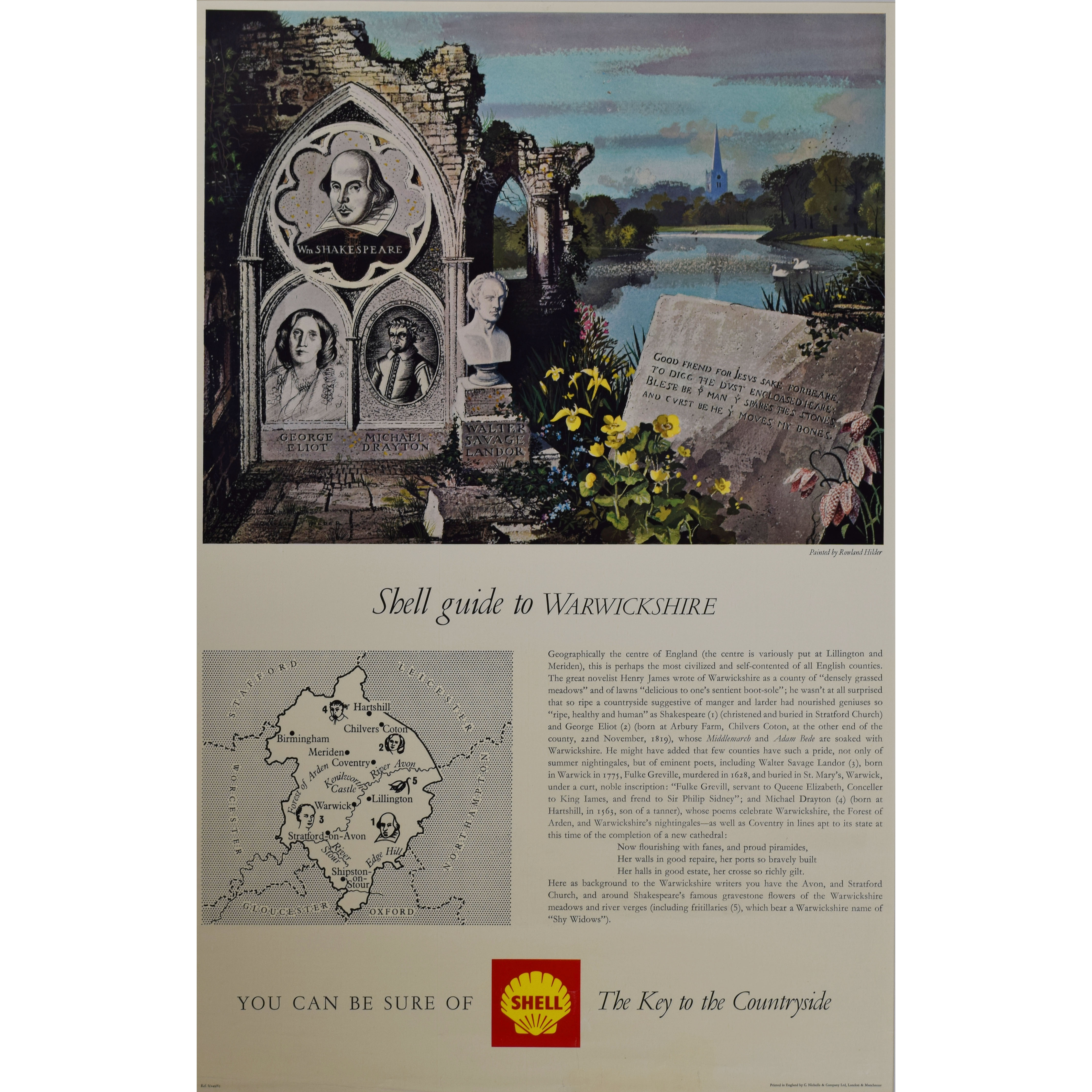
Rowland Hilder
Shell Guide to Warwickshire Original poster c. 1960s 76x51cm Shell commissioned a series of posters to go with their County Guide books, and they commissioned paintings by the leading artists of the day. Rowland Hilder was a well known landscape artist and book illustrator. Born in New York state, his English father moved the family to Kent, England in 1915. It was here his natural talent for drawing was noticed by his school. Later Hilder went to study at Goldsmith’s College in London. He was well known as an accomplished watercolorist, particularly in his sensitive handling of the sky and earth. Between 1964 and 1974 he was president of England’s Royal Institute of Painters in Watercolours. Condition: mounted in conservation mount and wrapped in plastic sleeve (mount hides short edge tears). -
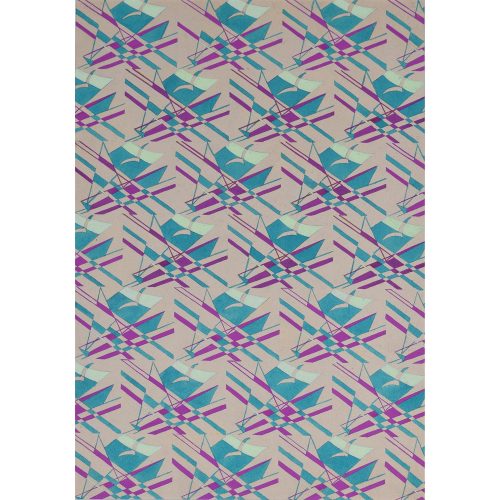
Margaret Macadam (1902-1991)
Seagull and Sailing Boat Wallpaper Design
Watercolour 27x20cm If you are interested email info@manningfineart.co.uk or call us on 07929 749056. -
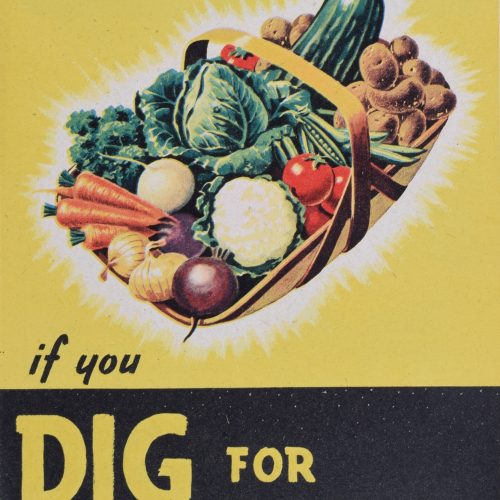
Dig for Victory Now
Norman Wilson, c1940
Dig for Victory Now Lithograph 18x12cm (7×4.7 inches), price includes frame. When rationing was at its height, what could be more appealing than a basket of fresh vegetables. What more incentive could be required to Dig For Victory Now? If you are interested email info@manningfineart.co.uk or call us on 07929 749056. -
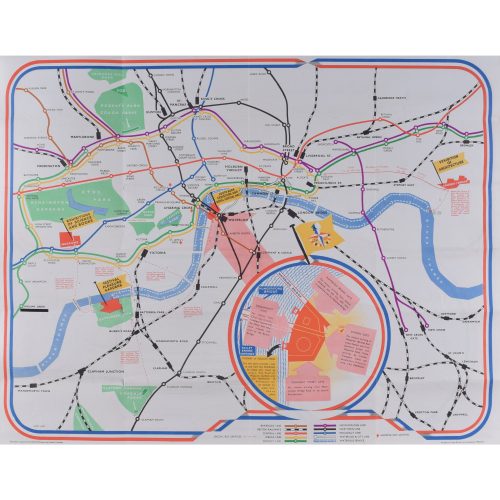
James Hart
Festival of Britain
Lithographic poster map 45 x 58 cm Folding map published for London Transport and British Railways for visitors to the 1951 Festival of Britain, featuring the Abram Games logo, details of water bus services, a detailed plan of the Lambeth exhibition area by Waterloo Bridge. If you are interested email info@manningfineart.co.uk or call us on 07929 749056. -
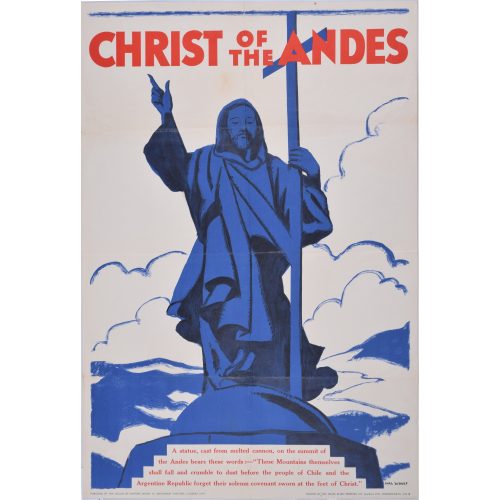 Hal Woolf Christ of the Andes Lithographic poster 76x50cm Printed by the David Allen Printing Co (London) Ltd., Wandsworth, SW18 Published by the League of Nations Union, 15 Crosvenor Crescent, London SW1 A statue, cast from melted cannon, on the summit of the Andes bears these words: "These Mountains themselves shall fall and crumble to dust before the people of Chile and the Argentine Republic forget their solemn covenant sworn at the feet of Christ." The League of Nations Union was formed in 2018 to promote international justice based upon the ideals of the League of Nations. Membership peaked in 1931 at over 400,000. In 1948 it was superseded by the United Nations Association. The statue of 'Christ the Redeemer of the Andes' is a monument unveiled in 1904 to celebrate the peaceful resolution of the border dispute between Argentina and Chile. If you are interested email info@manningfineart.co.uk or call us on 07929 749056.
Hal Woolf Christ of the Andes Lithographic poster 76x50cm Printed by the David Allen Printing Co (London) Ltd., Wandsworth, SW18 Published by the League of Nations Union, 15 Crosvenor Crescent, London SW1 A statue, cast from melted cannon, on the summit of the Andes bears these words: "These Mountains themselves shall fall and crumble to dust before the people of Chile and the Argentine Republic forget their solemn covenant sworn at the feet of Christ." The League of Nations Union was formed in 2018 to promote international justice based upon the ideals of the League of Nations. Membership peaked in 1931 at over 400,000. In 1948 it was superseded by the United Nations Association. The statue of 'Christ the Redeemer of the Andes' is a monument unveiled in 1904 to celebrate the peaceful resolution of the border dispute between Argentina and Chile. If you are interested email info@manningfineart.co.uk or call us on 07929 749056. -
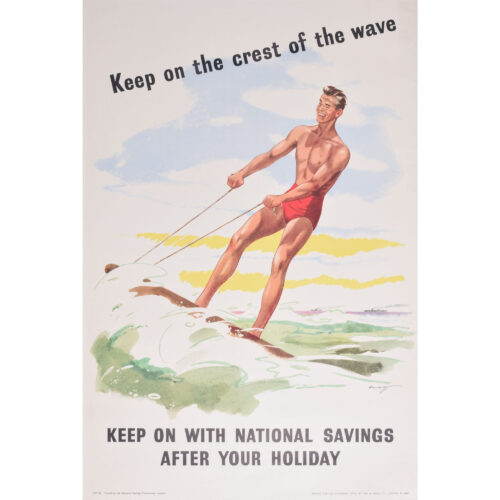
Keep on the Crest of the Wave
Original vintage poster 76 x 51 cm Issued by the National Savings Committee, London. Printed for HM Stationery Office by Fosh & Cross Ltd. An original vintage WW2 poster encouraging Britons to save via the National Savings scheme - like the cheery and composed surfer, we must keep saving to stay on the crest of the wave. Condition: generally very good; slight wear to right-hand margin. Not backed. If you are interested, please email info@manningfineart.co.uk or call us on 07929 749056. Click here for other original vintage National Savings posters. -
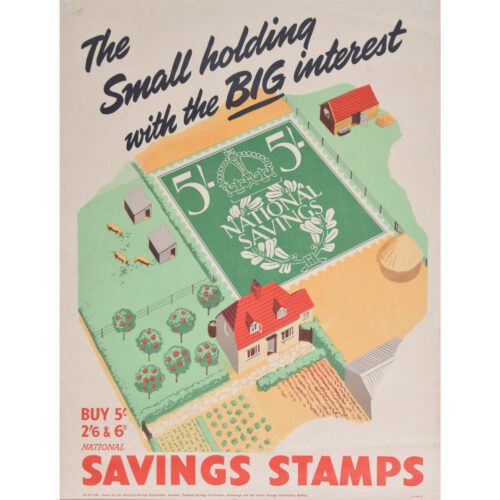
Savings Stamps - the Small Holding with the Big Interest
Original vintage poster 51 x 38 cm Issued by the National Savings Committee, London, the Scottish Savings Committee, Edinburgh, and the Ulster Savings Committee, Belfast. An original vintage WW2 poster encouraging Britons to save via the National Savings scheme. Condition: generally very good; few tiny edge tears, repaired; two pin holes to top corners; old fold as issued; and a couple of light creases. Not backed. If you are interested, please email info@manningfineart.co.uk or call us on 07929 749056. Click here for other original vintage National Savings posters. -
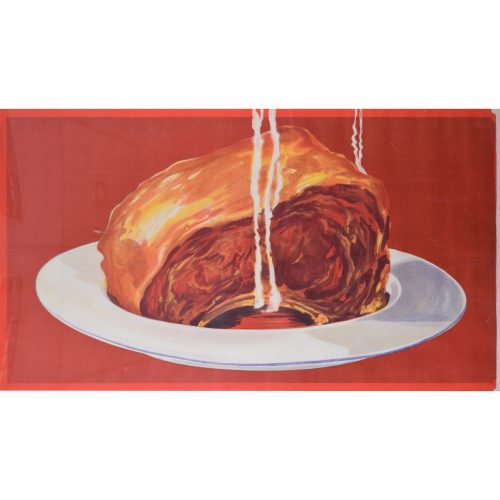
Rib of Beef
Original vintage poster 56 x 97 cm An original poster produced by Bisto to to advertise their gravy granules. With no lettering, the deep red poster is a bold and compelling advert which relies on the public's understanding that Bisto is the only choice. Condition: backed to linen, very good; a few repaired tears to right side. If you are interested, please email info@manningfineart.co.uk or call us on 07929 749056. Click here for other original vintage posters. -
Out of stock
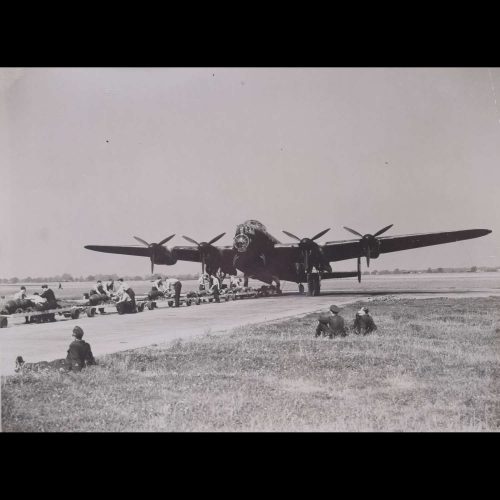
Lancaster Bomber being armed
Original Silver Gelatin photograph, c. 1942 16 x 21 cm Stamped to reverse 'Copyright this photograph must not be reproduced without the permission of Aeroplane' and 'This photograph has been passed by censor'. The photograph of the Swinderby based 50 Sqn - was taken in 1942. Either at the June reopening of the aerodrome with its new concrete runways (replacing grass) or in August when the photographers descended on the aerodrome again to take photographs for aircraft recognition purposes. Everitt survived the war - having flown 56 operations for which he was decorated three times, subsequently he was a bombing instructor, commanded a V-bomber squadron, and played golf into his nineties. He died in 2012 and the Telegraph published an excellent obituary. Provenance: from the collection of Philip J R Moyes, author of many books on the RAF, most notably The Pictorial History which ran to several volumes. -
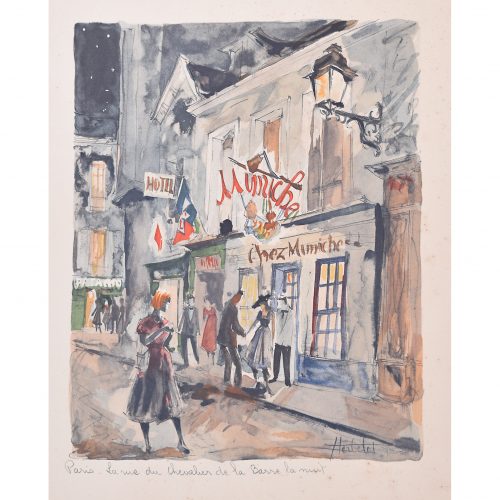 Franz Herbelot (French, active 1940s-1950s) Paris: La Rue de Chevalier de la Barre la nuit Lithograph 28 x 22 cm A fantastic lithograph by Herbelot which brilliantly captures the spirit of mid-century Paris. Little is known of Herbelot's life, but he is most notable for his views of Paris. The Rue de Chevalier de la Barre is a street in Montmartre named after the Knight de la Barre, François-Jean Lefebvre de la Barre, who died in 1766. Here, we see the street as it was in the 20th century, brimming with ladies and gentlemen dressed à la mode, bathed in the warm light of thriving bistros and hotels.
Franz Herbelot (French, active 1940s-1950s) Paris: La Rue de Chevalier de la Barre la nuit Lithograph 28 x 22 cm A fantastic lithograph by Herbelot which brilliantly captures the spirit of mid-century Paris. Little is known of Herbelot's life, but he is most notable for his views of Paris. The Rue de Chevalier de la Barre is a street in Montmartre named after the Knight de la Barre, François-Jean Lefebvre de la Barre, who died in 1766. Here, we see the street as it was in the 20th century, brimming with ladies and gentlemen dressed à la mode, bathed in the warm light of thriving bistros and hotels. -
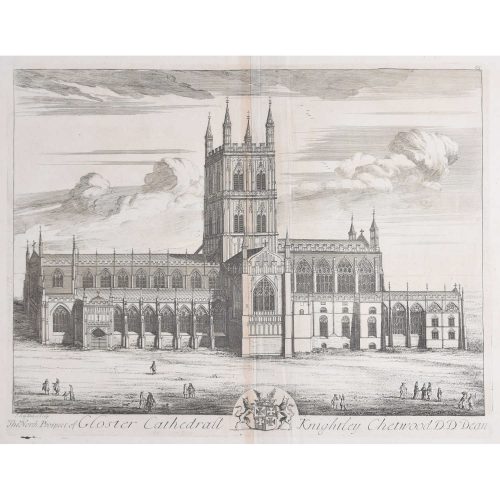
Johannes 'Jan' Kip (1652/3 - 1722)
The North Prospect of Gloster Cathedral (c.1716)
43 x 47 cm Copper engraving Johannes "Jan" Kip was a Dutch engraver, draughtsman and print dealer. After producing works for the court of William of Orange in Amsterdam, Kip followed William and Mary to London, settling in Farringdon and selling prints. Later, Kip collaborated with draughtsman and painter Leonard Knyff, and together they made a popular series of engraved views of English country houses. This print is from Sir Robert Atkyn's 'The Ancient and Present State of Gloucestershire'. In his usual manner - Kip was probably the foremost engraver of his time in England - he has placed figures before the Cathedral to give life - and scale - to the building. Condition: Generally very good with central vertical fold and adjacent parallel creases; one diagonal crease mid left to bottom centre. Will look very good when framed. -
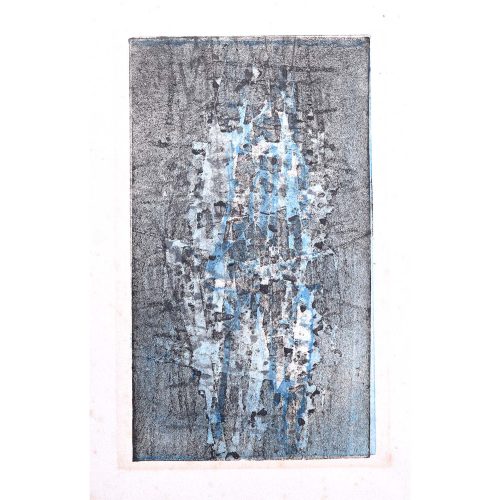
Henry Cliffe (1919-1983) Blue Figures
Etching Mid 20th Century 9.5x16.5cm Click here for biographical details and other pictures by the artist. If you are interested email info@manningfineart.co.uk or call us on 07929 749056. Condition: Good. -
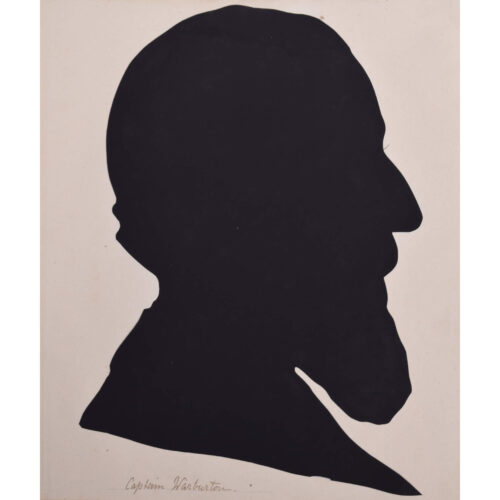
Silhouette (circa 1870)
Captain Warburton
Gouache, pen, and ink 52 x 44 cm Prior to photography, silhouettes were the easiest way of recording a person's appearance. This set might record the group present at a country house party, a wedding, or other similar convivial occasion. Condition: generally very good; occasional spots. If you are interested, please email info@manningfineart.co.uk or call us on 07929 749056. Click here for other silhouettes. -
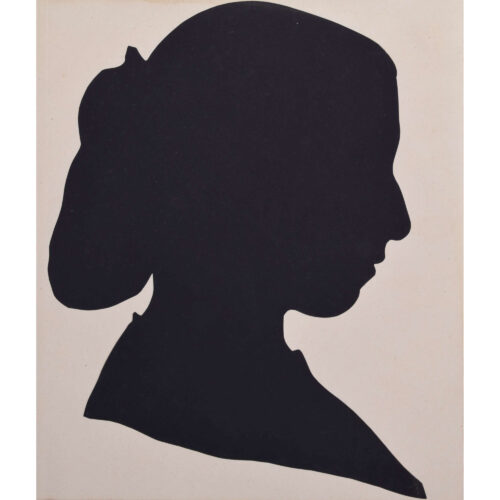
Silhouette of Lady I (circa 1870)
Gouache, pen, and ink 52 x 44 cm Prior to photography, silhouettes were the easiest way of recording a person's appearance. This set might record the group present at a country house party, a wedding, or other similar convivial occasion. Condition: generally good; some staining to upper edge. If you are interested, please email info@manningfineart.co.uk or call us on 07929 749056. Click here for other silhouettes. -
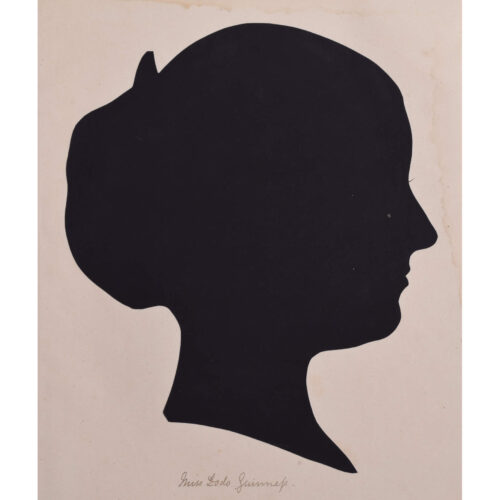
Silhouette (circa 1870)
Miss Dodo Guinness
Gouache, pen, and ink 52 x 44 cm Adelaide Maud Guinness, nicknamed 'Dodo', was descended from the banking line of Guinnesses. Her father was the barrister and MP Richard Samuel Guinness. Dodo married Edward Cecil Guinness, the 1st Earl of Iveagh and her third cousin, in 1873. Edward's father had died in 1868, after which Edward inherited a share of the famous Guinness brewery. The Guinness family seat is Elveden Hall in Suffolk. Prior to photography, silhouettes were the easiest way of recording a person's appearance. This set might record the group present at a country house party, a wedding, or other similar convivial occasion. Condition: generally good; some staining to upper edge. If you’d like to know more, please email info@manningfineart.co.uk or call us on 07929 749056. -
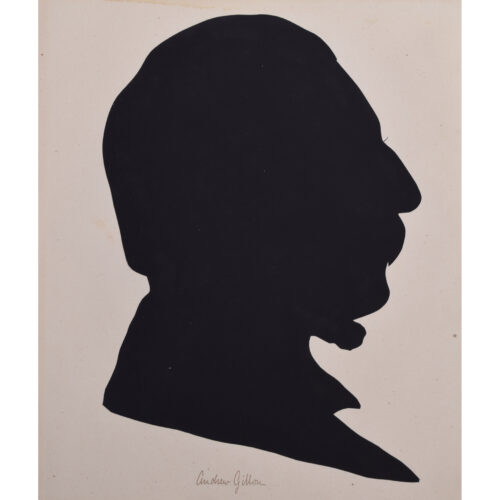
Silhouette (circa 1870)
Andrew Gillon
Gouache, pen, and ink 52 x 44 cm Prior to photography, silhouettes were the easiest way of recording a person's appearance. This set might record the group present at a country house party, a wedding, or other similar convivial occasion. Condition: generally good; some staining to upper edge. If you are interested, please email info@manningfineart.co.uk or call us on 07929 749056. Click here for other silhouettes. -
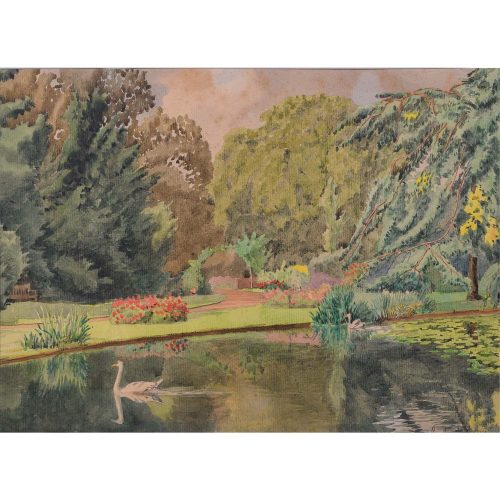
Major F A Molony
Fellows’ Garden Emmanuel College Cambridge (19th century)
Watercolour 22x30cm In the Royal Engineers, Major F A Molony was an accomplished watercolourist who published several views of Cambridge. If you are interested email info@manningfineart.co.ukor call us on 07929 749056. Condition: Good. -
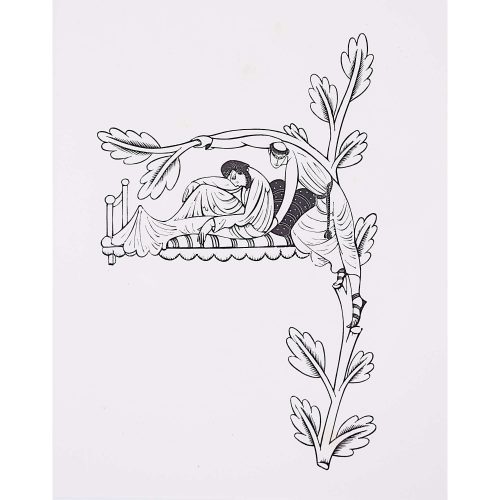
Eric Gill
Canterbury Tales The Summoner's Tale
Woodblock Print Published Hague & Gill 1934 in an unnumbered edition of 300 23x21cm Following Chichester Technical and Art School, Gill moved to London in 1900 to train with the ecclesiastical architects W D Caroe. Finding architecture somewhat pedestrian he took stonemasonry lessons at Westminster Technical Institute and calligraphy lessons at the Central School of Arts and Crafts, coming under the influence of Edward Johnson, the designer of the London Underground's own typeface. In 1903 he ceased his attempts to become an architect, instead becoming a monumental mason, letter-cutter and calligrapher. Based in Ditchling, he began direct carving of stone figures, the semi-abstract figures taking their influence from mediaeval statuary, mixed with influences from Classical statuary from the Greeks and Romans, with a little post-Impressionism added in. With major commissions from Westminster Cathedral for its Stations of the Cross (1914), a series of War Memorials including the Grade II* memorial in Trumpington, and three of the sculptures for Charles Holden's 1928 headquarters of London Underground at 55 Broadway, St James's, and a series of sculptures for the new 1932 Broadcasting House. The list continues. Never one to rest on his laurels, he was at the same time engaged in typographical adventures. He had collaborated with Edward Johnson on the latter's initial thoughts on his London Transport typeface, but in 1925 designed Perpetua on his own, and Gill Sans between 1927-30. For the Golden Cockerel Press he created, in 1929, a bolder typeface to complement wood engravings. And of course Gill was publishing decorated books. His 1929 Canterbury Tales was an epic work, with a whole series of beautiful wood engravings such as this one. The present print is from the 1934 edition for Faber & Faber ('Engravings 1928-1933 by Eric Gill') he printed with his son-in-law, Rene Hague, produced with the original engraved wood blocks. In Chaucer's Tales, the Summoner's Tale tells the story of the man who summonsed people to the ecclesiastical courts. It satirises the friar, considering him to be corrupt. Philip Hofer was a curator and collector, and commissioned this fine Ex Libris plate from Gill. If you are interested email info@manningfineart.co.uk or call us on 07929 749056. Condition: Generally very good condition. -
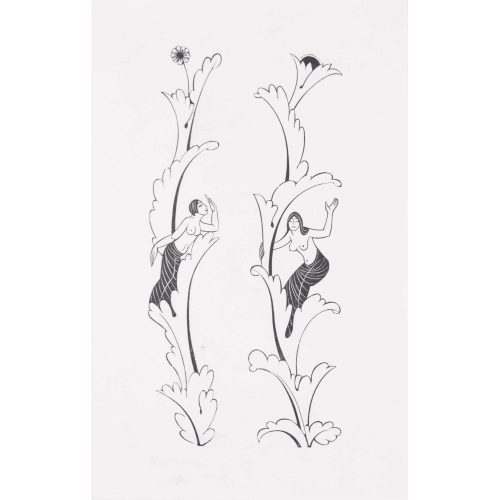
Eric Gill (1882-1940) Canterbury Tales Border - Two nudes i
Woodblock Print Published Hague & Gill 1934 23x21cm Condition: very good Click here for biographical details and other prints by Gill. If you are interested email info@manningfineart.co.uk or call us on 07929 749056. -
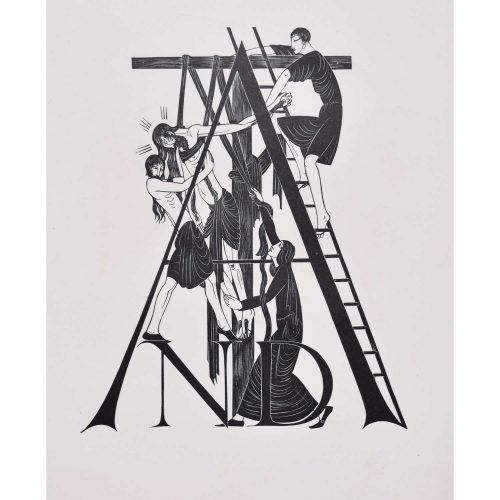
Eric Gill (1882-1940) The Deposition from the Cross
Woodblock Print Published Hague & Gill 1934 23x21cm Christ's body is taken down from the Cross, Mary assists by holding the ropes, and two men - Joseph of Arimathea and Nicodemus climb the ladder - one of the instruments of the passion. Click here for biographical details and other prints by Gill. If you are interested email info@manningfineart.co.uk or call us on 07929 749056. -
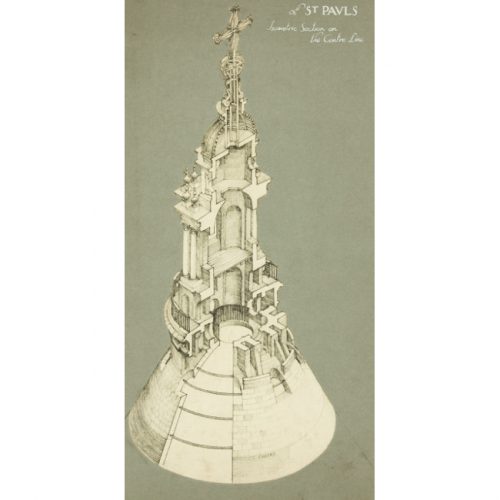
John Charles Rogers RIBA (1888-1939)
The Lantern, St Paul's Cathedral, London
41 x 18 cm (61 x 7") Graphite on paper Signed JC Rogers Inscribed 'Isometric section on the centre line'. Rogers was a practising architect who trained at Regent Street Polytechnic and was then assistant to Messrs Harvey & Potter. -
Out of stock
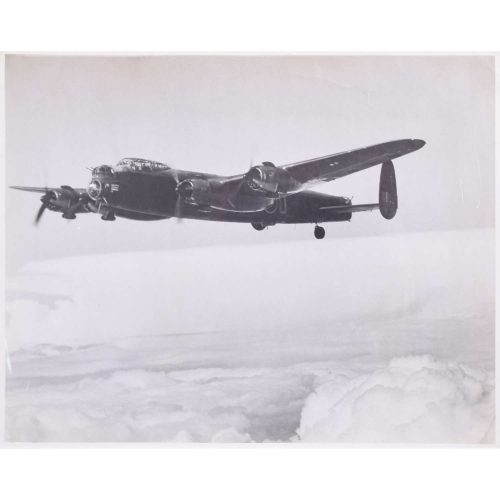
Lancaster bomber
Original Silver Gelatin photograph, 1944 19 x 24 cm Published in Aeroplane Magazine August 18 1944 p175 Press release label to reverse reads: "CL 561 British Official Photograph: Crown Copyright Reserved. "RAF Bomber Command Lancasters Attack Flying Bomb Bases. On 27.4.44 Lancasters of RAF Bomber Command attacked flying bomb bases in Norther France. Picture shows:- RAF Lancaster flies back to base after bombing flying bomb sites in Northern France." Condition: Generally very good, small loss to top outside image -
Out of stock
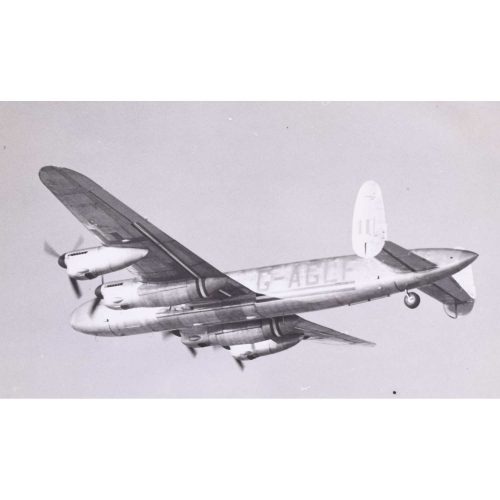
Lancastrian airliner G-AGLF
Original Silver Gelatin photograph, c. 1945 20 x 29 cm Stamped to reverse 'Daily Herald, 2 Chester Street, Oxford Road, Manchester; Copyright photo' In 1945, deliveries commenced of 30 British-built Lancastrians for BOAC. On a demonstration flight on 23 April 1945, G-AGLF flew 13,500 mi (21,700 km) from England to Auckland, New Zealand in three days, 14 hours at an average speed of 220 mph (354 km/h). G-AGLF's last flight was on Sunday 11 May 1947 when it crashed while landing at a pipeline station in the desert between Cairo and Busreh. The Lancastrian was fast, had a long range, and was capable of carrying a heavy load, but space inside was very limited as the Lancaster had been designed with space for its seven crew dispersed throughout the fuselage, and with the majority of the load being carried in the 33 ft (10.05 m) long bomb bay. Consequently, as passengers are bulky but low in weight, it was not suited to carry large numbers of passengers, but was suitable for mail and a small number of VIP passengers. BOAC used it for flights between England and Australia from 31 May 1945. It also served with the RAF; RAF Lancaster I serial number PD328, was converted to a Lancastrian and renamed Aries, as well as serving with Qantas and Flota Aérea Mercante Argentina. Lancastrians were used during the Berlin Airlift to transport petrol; 15 aircraft made over 5,000 trips. In 1946 a Lancastrian operated by BSAA was the first aircraft to make a scheduled flight from the then-newly opened London Heathrow Airport. Provenance: from the collection of Philip J R Moyes, author of many books on the RAF, most notably The Pictorial History which ran to several volumes. Condition: Marginal creases, a little foxing to reverse -
Out of stock
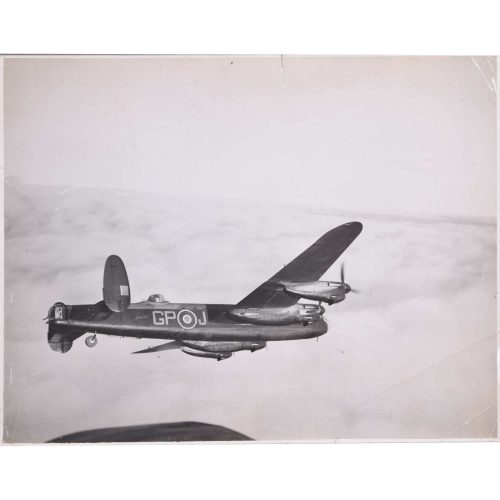
Lancaster Bomber W4113 GP-J
Original Silver Gelatin photograph, c. 1944 19 x 24 cm Published in Aeroplane Magazine, 4 February 1944. Stamped to reverse 'Wanted by 31 Janary' making this the original photograph used by the editing team at Aeroplane; and 'T[emple] P[ress] Ltd'. Photograph in official Air Ministry Second World War Collection, glass plate negative taken by F/O S A Devon. Lancaster B Mark I, W4113 ‘GP-J’, of No. 1661 Heavy Conversion Unit based at Winthorpe, Nottinghamshire, in flight. W4113 was a veteran aircraft having flown on a number of raids with Nos. 49 and 156 Squadrons RAF in 1942 and 1943, and was sent to a Heavy Conversion Unit where airmen were trained to operate the Lancaster. Became 4969M on 9/12/44, being reclassified as a ground instruction aircraft. W4113 took part in the following bombing raids: No. 49 Squadron; 1) Düsseldorf, 15-16/08/42; 2) Osnabrück, 17-18/08/42; 3) Flensburg, 18-19/08/42; 4) Gardening, Bornholm, 20-21/08/42; 5) Kassel, 27-28/08/42; 6) Saarbrücken, 01-02/09/42; 7) Duisburg, 06-07/09/42; 8.) Frankfurt, 08-09/09/42; 9) Bremen, 13-14/09/42; 10) Wilhelmshaven, 14-15/09/42; 11) Gardening, Kattegatt, 18-19/09/42; 12) Wismar, 01-02/10/42; 13) Aachen, 05-06/10/42; 14) Wismar, 12-13/10/42; 15) Kiel, 13-14/10/42; 16) Cologne, 15-16/10/42; 17) Genoa, 22-23/10/42; 18.) Genoa, 07-08/11/42; 19) Hamburg, 09/10/11/42; 20) Genoa, 15-16/11/42; 21) Stuttgart, 22-23/11/42; 22) Turin, 28-29/11/42; 23) Mannheim, 06-07/12/42, 24) 20-21/12/42. No. 156 Squadron.: a) Nuremburg, 25-26/02/43. It was produced in the third production batch of 207 aircraft ordered from A. V. Roe Co., Ltd., as part of Contract No. B69274/40 (as extended) under Works Order No. 7671, W4102-W4140, W4154-W4201, W4230-4279, W4301-W4340 and W4355-W4384. Deliveries commenced 07/42, completed 11/42 (average rate of production, approximately 13 aircraft per week). Merlin XX and XXII engines. Original Contract covered 453 aircraft in this batch but 243 were cancelled (W4385-W4900, W4414-4463, W4481-W4524, W4537-W4385, W4600-W4641 and W4655-W4700). Provenance: from the collection of Philip J R Moyes, author of many books on the RAF, most notably The Pictorial History which ran to several volumes. Condition: a couple of old edge tears and creases, visible in image. -
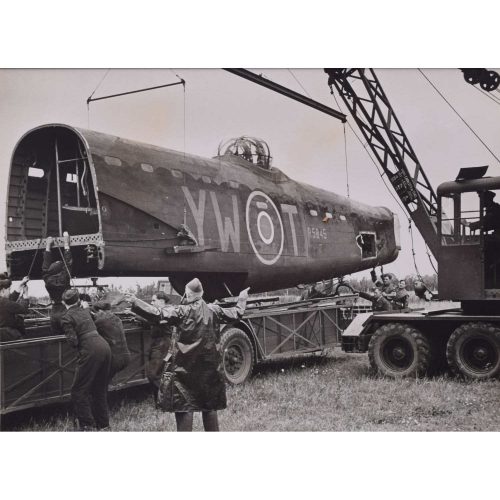
Lancaster Bomber R5845 YW-T
Original Silver Gelatin photograph 19 x 25 cm Stamped to reverse "Copyright Hulton Press Ltd" The RAF Maintenance Unit are recovering R5845 which was on the strength of 1660 Heavy Conversion Unit Winthorpe in October 1943 from the runway. Newark Air Museum have another photograph - included in the attached photographs, but not available for sale - of the entire aeroplane on a string of Queen Mary trailers. R5845 was finally written off on the night of 18/19 July 1944 on a mission to destroy a railway junction at Revigny in France. With 11 x 1000lb and 3 x 500lb bombs nothing was heard of the aircraft after takeoff and it failed to return to base. Following the war it was established that it was intercepted by a night fighter on its way home. Four of the crew evaded capture, and one was made PoW, the Pilot F/O TEW Davis of RAAF being buried in the churchyard at Heiltz-le-Maurupt, Marne, France. Provenance: from the collection of Philip J R Moyes, author of many books on the RAF, most notably The Pictorial History which ran to several volumes. Condition: mostly good. -

Lancaster Bomber with 8000lb cookie bomb
Original Silver Gelatin photograph, September 1943 19 x 25 cm Stamped to reverse 'Copyright this photograph must not be reproduced without the written permission of The Aeroplane.' BRITISH OFFICIAL PHOTOGRAPH CH 10939(WK) Air Ministry Photo- Crown Copyright Reserved (Picture issued September 1943) THE RAF's EIGHT THOUSAND POUND BOMB Stamped to reverse 'British Official Photograph, Crown Copyright Reserved, Supplied by BIPPA, Passed for publication by Ministry of Information'. The press release states: First official photographs of the RAF's 8,000 lb and 4,000 lb bombs are now released. Their weight has been felt with devastating effect on enemy targets in Italy and Germany. Picture shows:- Close-up of an 8,000 lb bomb in front of the Lancaster which will carry it on the night's raid. The 8000 lb 'super cookie' was a 'blockbuster' bomb, so-called because it could destroy an entire block of flats on its own. The Germans called these large bombs 'Luftminen' - airmines - as during the Blitz the large bombs used by the Luftwaffe were adapted marine mines. Judging by the length of the hair of the person sitting by the bomb, this is a member of the WAAF. WAAFs were often used to drive tractors on aerodromes during the war. Condition: generally good Provenance: from the collection of Philip J R Moyes, author of many books on the RAF, most notably The Pictorial History which ran to several volumes. -
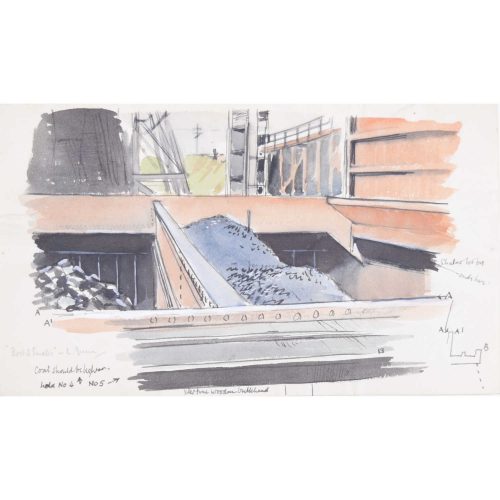
Laurence Dunn (1910-2006)
Coal Barge (c.1950)
12.5 x 25 cm Watercolour and ink Signed 'L Dunn' lower left Extensively inscribed to bottom corners, including comments 'coal should be lighter' indicating this is a preliminary watercolour for a future painting. He also makes reference to the continued existence of a 'wartime wooden bulkhead' - added to make the ship more resilient in the event of enemy action. Laurence Dunn (1910-2006) was a well-known British marine artist and writer. The World Ship Society published the following obituary for Dunn: DUNN, Laurence. [December 15 2006 — Lloyds List] Many readers will be saddened by the death of well-known marine artist and writer Laurence Dunn in his 97th year. A man of encyclopaedic knowledge, he began his lifelong love of ships in Brixham, where he meticulously recorded passing traffic with the exquisitely accurate line drawings which later became something of a trademark. While studying at London’s Central School of Art his work was noticed by the Southern Railway, which commissioned profiles of its fleet, and this in turn led to work for Orient Line, where he also designed the well-known corn-coloured hull, and later Thorneycroft, where he helped with shaping draft plans for a new royal yacht. During the second world was he worked for naval intelligence at the Admiralty, where his technique did much to improve recognition standards, and greatly expanded his shipping clientele, becoming personally known to many chairmen. As well as the shipping press he worked for mainstream publications such as Everybody’s, Sphere and the upmarket comic Eagle. Through his many contacts he enjoyed going to sea in a great variety of ships from aircraft carriers to colliers. Laurence wrote several books, starting with ship recognition titles which introduced new standards of layout, but his best known work was probably Passenger Liners, which was widely taken up by the travel trade. His love of Greece, where he was an early publicist of island cruising, let to involvement in reshaping various passenger liners beginning with Greek Line’s OLYMPIA. In later life he designed several sets of shipping stamps for the Crown Agents, produced photographic volumes on Thames and Mediterranean shipping and still found time to enjoy the passing Thames traffic. Our sympathies go to his wife Jennifer, who provided succour to the many ship lovers who beat a path to the welcoming door of their Gravesend home. -
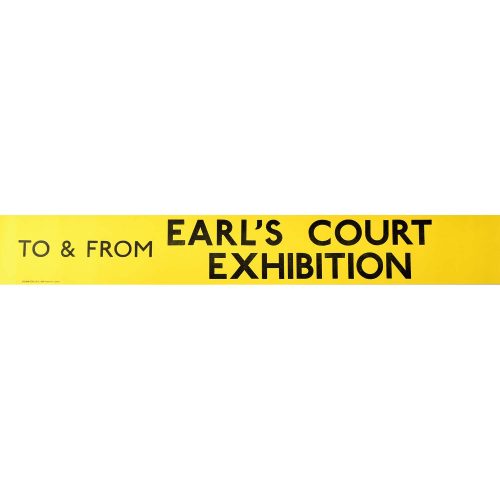
Earl's Court Exhibition Routemaster Slipboard Poster c1970
Screenprint poster 64x9cm Printed for London Transport for use on Routemaster or RT buses - the traditional red London bus with open platform and hop-on-hop-off facility. If you are interested email info@manningfineart.co.uk or call us on 07929 749056. Condition: Excellent. -
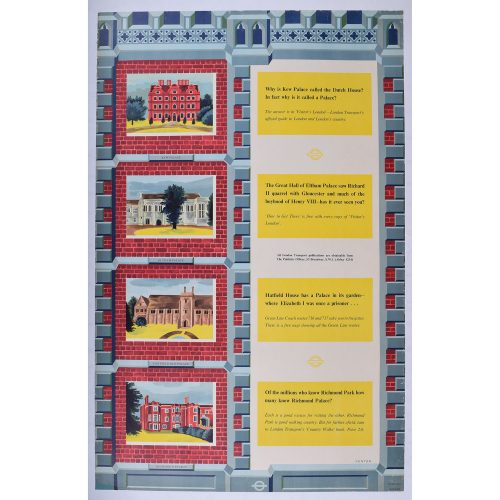
Ernest William Fenton (b. 1922)
Transport for London: Kew Palace, Eltham Palace, Hatfield Old Palace, Richmond Palace
Printed for London Transport Lithographic poster 40x25 inches Educated at Selby College of Art, Leeds College of Art and the Royal College of Art, William Fenton designed posters for London Transport from 1952-1976. If you are interested email info@manningfineart.co.ukor call us on 07929 749056. -
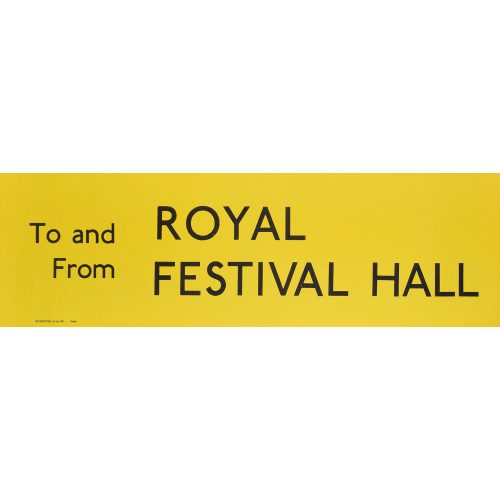
Royal Festival Hall Routemaster Slipboard Poster c1970
Screenprint poster 64x19cm In a black hand-finished frame. Printed for London Transport for use on Routemaster or RT busses. If you are interested email info@manningfineart.co.uk or call us on 07929 749056. -
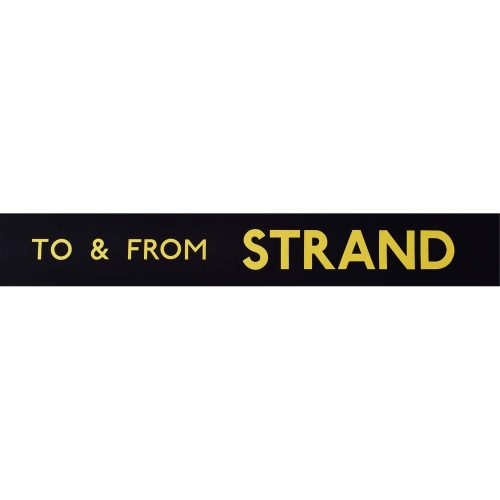
Anon.
Strand Routemaster
Slipboard Poster c.1970 Screenprint poster 64x9cm In a black hand-finished frame. Printed for London Transport for use on Routemaster or RT busses. If you are interested email info@manningfineart.co.uk or call us on 07929 749056. Condition: Excellent. -
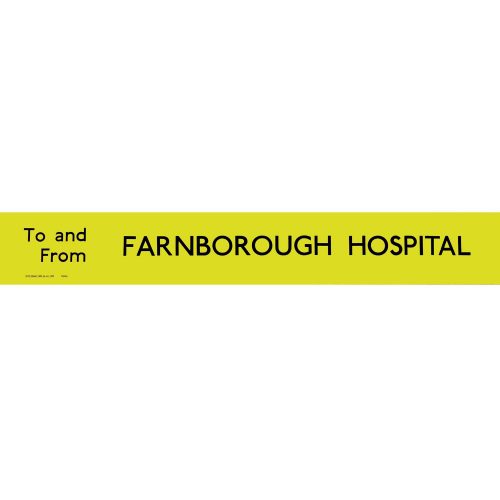
Anon.
Farnborough Hospital Routemaster
Slipboard Poster c.1970 Screenprint poster 64x9cm In a black hand-finished frame. Printed for London Transport for use on Routemaster or RT buses. If you are interested email info@manningfineart.co.uk or call us on 07929 749056. Condition: Excellent.

